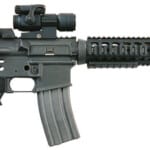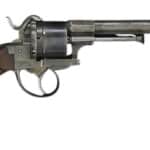
Introduction
The Vetterli rifle stands as a milestone in the evolution of military small arms. Born during a period of intense innovation in late 19th-century Europe, this Swiss rifle not only revolutionized bolt-action mechanisms but also set the stage for many advancements that followed. Its development, attributed to the ingenuity of Swiss engineer Friedrich Vetterli and his collaborators, reflects a rich legacy of technical breakthroughs, rigorous engineering, and strategic adaptation to evolving battlefield needs.
Historical Context and Origins
In the mid-1800s, Switzerland experienced a renaissance of military engineering as nations across Europe sought to modernize their arsenals. Against this backdrop of rapid technological change, the Swiss army embarked on a quest to improve its infantry weapons. In 1869, Friedrich Vetterli emerged as a central figure in this movement. Tasked with developing a firearm that could offer a faster rate of fire and improved reliability compared to traditional single-shot rifles, Vetterli and his team created a design that would eventually transform military small arms.
The Vetterli rifle was not conceived in isolation. Its creation reflected the collaborative spirit of an era when ideas about rapid-fire capability, efficient reloading, and enhanced safety were being actively explored. Archival military records and contemporary analyses reveal that while Friedrich Vetterli’s name is most closely associated with this rifle, the design benefited from the contributions of several innovative minds working in a period marked by both experimentation and refinement.
Innovations in Design and Engineering
The First Bolt-Action Repeating Rifle
One of the most significant achievements of the Vetterli rifle was its adoption as one of the first bolt-action repeating rifles by a military force. Prior to its development, armies relied heavily on single-shot or manually loaded breech-loading rifles, which limited the rate of fire in combat. The bolt-action mechanism of the Vetterli allowed soldiers to cycle the action quickly, chambering a new round with each operation of the bolt. This innovative system featured a robust locking mechanism—comprising a series of locking lugs and a carefully engineered bolt body—that not only ensured safe operation but also improved the overall reliability of the weapon under adverse conditions.
Contemporary military historians have noted that “the Vetterli rifle’s bolt-action design set a new standard for reloading speed and reliability, paving the way for the development of later systems that would dominate military arsenals worldwide.” Its influence is seen in the progression toward more sophisticated bolt-action systems later in the century, notably influencing designs such as the Swiss Schmidt-Rubin and the early Mauser rifles.
The Tube Magazine System
Another groundbreaking feature of the Vetterli rifle was its innovative tubular magazine system. Located beneath the barrel, the tube magazine was engineered to hold up to 11 rounds in certain configurations. This design provided a substantial advantage over previous single-shot mechanisms, ensuring that soldiers could maintain a continuous rate of fire without the need for constant reloading.
The magazine’s configuration allowed for a smooth feeding of cartridges into the chamber. The curved design of the magazine and the precise engineering of the feeding mechanism minimized the risk of misfeeds—a common issue in early repeating rifles. Moreover, the placement of the magazine contributed to a balanced weight distribution along the rifle’s length, enhancing its handling and aiming stability during rapid fire.
Cartridge Evolution: From Rimfire to Centerfire
Initially, the Vetterli rifle was chambered in the 10.4×38mm rimfire cartridge. Rimfire ammunition, where the firing pin strikes the rim of the cartridge to ignite the primer, was common in the mid-19th century. However, while effective for its time, rimfire cartridges had limitations in terms of reliability and ease of manufacture. Recognizing these shortcomings, later models of the Vetterli were converted to fire a centerfire cartridge—designated as the 10.4×38mmR. In centerfire ammunition, the primer is centrally located in the base of the cartridge, offering more consistent ignition and improved performance under varying environmental conditions.
This evolution from rimfire to centerfire was a critical advancement. Not only did it enhance the operational reliability of the rifle, but it also aligned with broader trends in military small arms development. Experts have observed that “the transition to centerfire ammunition marked a pivotal moment in firearm design, enabling higher pressures and more efficient combustion, which translated into improved muzzle velocity and accuracy.” Such improvements were vital for maintaining the competitive edge of the Swiss military.
Advanced Safety Features
Ahead of its time, the Vetterli rifle incorporated a manual safety mechanism designed to lock the bolt and prevent accidental discharges. This safety feature was a crucial innovation, particularly given the complexities of operating a repeating rifle under combat conditions. By allowing the shooter to secure the action when not in use, the safety mechanism reduced the risk of accidental engagement and ensured that the rifle could be handled more securely during field maneuvers. In comparative evaluations, this manual safety was noted for its simplicity and effectiveness, setting a benchmark for future firearm designs.
Models and Variants
The evolution of the Vetterli rifle is best understood by examining its multiple models, each reflecting incremental improvements and adaptations to meet specific military requirements.
Vetterli M1869
The initial model, the Vetterli M1869, introduced the groundbreaking bolt-action and tubular magazine system. Chambered in the 10.4×38mm rimfire cartridge, this model set the foundation for future developments. Its design was revolutionary for its time, offering a level of rapid-fire capability that had not been seen in military service before.
Vetterli M1871
Building on the success of the M1869, the Vetterli M1871 introduced minor modifications aimed at enhancing durability and ease of maintenance. These modifications included refinements in the bolt design and improvements in the magazine feeding mechanism. Although the changes were subtle, they contributed to a more reliable and user-friendly rifle that could withstand the rigors of military use.
Vetterli M1878/81
The Vetterli M1878/81 marked a significant evolution in the rifle’s design. This model featured a strengthened action capable of handling the higher pressures associated with centerfire ammunition. The conversion to the 10.4×38mmR centerfire cartridge not only improved ignition reliability but also enhanced ballistic performance. Field tests of the M1878/81 demonstrated a slight increase in muzzle velocity—approximately 1,400 ft/s compared to the 1,345 ft/s achieved by the earlier rimfire version—confirming the technical benefits of the conversion.
Vetterli-Vitali M1870/87
In addition to its service with the Swiss army, the Vetterli design found favor with international customers. The Italian variant, known as the Vetterli-Vitali M1870/87, introduced a distinct four-round Vitali box magazine and was chambered in the 10.4×47mmR cartridge. This adaptation reflected Italy’s specific operational requirements and its desire for a firearm that could offer both rapid reloading and improved performance in diverse combat scenarios. The Italian variant further underscores the versatility and adaptability of the original Vetterli design.
Performance and Operational Use
The performance characteristics of the Vetterli rifle were a direct result of its innovative engineering. With an effective range of approximately 300 meters, the rifle provided sufficient reach for most infantry engagements of its time. The combination of a rapid bolt-action cycling mechanism and the high-capacity tubular magazine enabled a skilled marksman to achieve a rate of fire between 10 and 15 rounds per minute—an impressive feat compared to the single-shot rifles that preceded it.
The muzzle velocity of the original 10.4×38mm rimfire cartridge was recorded at around 1,345 ft/s (410 m/s), while the centerfire version pushed this figure slightly higher to approximately 1,400 ft/s. These performance metrics, while modest by modern standards, were significant during a period when most military rifles were still transitioning from muzzle-loading designs to more efficient breech-loading systems. The improvements in ballistic performance contributed to the rifle’s reputation for reliability and accuracy in both training exercises and operational deployments.
Soldiers valued the Vetterli for its robustness under harsh conditions. Field reports and historical assessments have noted that the rifle’s mechanical simplicity and sturdy construction allowed it to perform reliably even in adverse weather or on rugged terrain. The manual safety feature, in particular, was praised for its ease of use and the added confidence it provided during combat operations.
Production and Enduring Legacy
Between 1869 and 1889, historical production records estimate that approximately 600,000 Vetterli rifles were manufactured for the Swiss army. This high production volume not only reflects the rifle’s popularity and effectiveness but also underscores the scale of Switzerland’s commitment to modernizing its military capabilities during this transformative period.
In addition to the Swiss production, roughly 70,000 Vetterli-Vitali rifles were produced for the Italian army. The adoption of the rifle by multiple nations highlights its international impact and the recognition of its technical superiority. These production figures, while subject to minor discrepancies in archival data, attest to the widespread use and influence of the Vetterli design.
The legacy of the Vetterli rifle extends far beyond its service life. Many of the design principles it introduced—most notably the bolt-action mechanism and the efficient tubular magazine system—became standard features in later military rifles. The innovations pioneered by the Vetterli not only influenced the subsequent Swiss Schmidt-Rubin series but also contributed to the evolution of bolt-action designs adopted by militaries around the world. In essence, the Vetterli rifle laid the groundwork for the modern era of rapid-fire, magazine-fed small arms.
Conclusion
The Vetterli rifle remains an enduring symbol of Swiss ingenuity and a pivotal chapter in the history of military firearms. From its inception in 1869, this groundbreaking rifle redefined the expectations of rapid-fire capability and reliability on the battlefield. Its pioneering bolt-action system, innovative tubular magazine design, and successful transition from rimfire to centerfire ammunition exemplify a series of technical achievements that resonated through subsequent generations of firearm development.
The multiple variants of the Vetterli—ranging from the original M1869 to the enhanced M1878/81 and the Italian Vetterli-Vitali—reflect a continuous process of refinement and adaptation, driven by evolving military tactics and technological possibilities. With production numbers reaching into the hundreds of thousands, the Vetterli rifle was more than just a weapon; it was a catalyst for change that shaped the future of military small arms.
In military history, the Vetterli rifle stands as a testament to the impact of thoughtful engineering and innovation. Its design principles, which emphasize speed, reliability, and user safety, continue to influence modern firearm technology. As modern scholars and firearm enthusiasts continue to examine its contributions, the Vetterli remains a source of inspiration—a reminder that the pursuit of excellence in design can lead to enduring advancements that redefine an entire field.
Through its groundbreaking innovations and lasting influence, the Vetterli rifle occupies a unique position in the annals of military history. It represents the intersection of technical prowess and strategic necessity, embodying a period when rapid-fire capabilities began to transform warfare. The Vetterli rifle not only met the immediate needs of its era but also charted a course for future developments that have come to define modern infantry weaponry.
In every aspect—from its mechanical ingenuity to its robust operational performance—the Vetterli rifle exemplifies the kind of innovation that continues to shape the evolution of military small arms. It remains an essential subject of study for historians, engineers, and military enthusiasts alike, offering invaluable insights into the dynamic interplay between technology and tactical necessity.
Read more about the Vetterli Rifle here:
If you know of any forums or sites that should be referenced on this listing, please let us know here.






